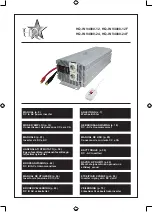
1. INSTALLATION
1.1.
Space requirements
The generator must be installed in a ventilated space,
supplying sufficient air necessary for the combustion of
the motor.
The space must be separate and acoustically insulated
from living areas.
The generator should be positioned so normal mainte-
nance operations can be easily performed.
1.2.
Fastening the unit
To fasten the unit securely, a base should be installed to
absorb vibrations and support the weight.
Drill holes in the base according to the instructions in
fig. 1.
1.3.
Ventilation
The generator is equipped with an internal forced cooling
system through a water/air exchanger.
The air needed for combustion is taken in through the
opening on the base (fig. 2) so care must be taken to
ensure this opening is always free.
2. COOLING WATER CIRCUIT
The engine of generators IS9.5, is cooled by a closed
circuit heat exchanger.
Upon installation, a raw water feed circuit for cooling and
a wet exhaust system should be fitted for cooling.
2.1.
Raw water feed system
Boats usually use one of two systems to collect water
(fig. 3):
1
- Direct infeed system
2
- System with baffle
Mase recommends the direct infeed system (ref.1 fig. 3)
since this system prevents over pressurization of the
system.
Do not apply any type of external
sea strainer to the direct feed system.
THE DIRECT INFEED SYSTEM SUPPLIED BY MASE
HAS BEEN MODIFIED TO PREVENT SOLID OBJECTS
FROM ENTERING THE SYSTEM AND BLOCKING IT.
IF OTHER MATERIALS ARE USED, MORE CARE AND
MORE FREQUENT CLEANING IS NECESSARY.
The baffle system might cause the following problems:
a
- If installed with the slots facing the bow:
In this case, during navigation and with the electric
generator off, pressure is accumulated in the water
infeed duct which might cause the system to fill up,
even as far as the exhaust port, allowing water to enter
the cylinders.
b
- If installed with the slots facing the stern:
In this case, a depression might accumulate in the
water infeed duct during navigation, preventing the
water pump from starting up the cooling plant, or
limiting the capacity and subsequently causing the
electric generator to overheat.
2.2
Typical installation with electric generator
above the water-line (fig. 4)
1
Raw water intake
2
Intake valve
3
Drain valve
4
Water filter
5
Electric generator
6
Barrel muffler
7
Silencer
8
Exhaust through-hull
9
Water line
A
- Hose - internal diameter 50 mm (1.96")
B
- Hose - internal diameter 15 mm (.59")
C
- Clamps
D
- Hose - internal diameter 50 mm (1.96")
The measurements shown in fig. 4-5 should
correspond exactly.
The muffler (fig.4, ref.6) collects the water in the
exhaust pipes when the generator motor is turned
off, preventing it from flowing into the motor through
the exhaust manifold and valve. For this reason it is
essential the position of the muffler and the length of
the hoses indicated on the installation chart be fully
respected.
INFORMATION
WARNING
WARNING
9






























